Warehouse 51 is a very enjoyable auction and set collection game from Bruno Faidutti (Mission: Red Planet, Citadels), Sérgio Halaban (Sheriff of Nottingham), and André Zatz (Sheriff of Nottingham). The game is recommended for 3-5 players aged 10 and up and plays in around 30 to 40 minutes. It made its debut at Gen Con and is published by Funforge and Passport Game Studios.
Summary
It’s 2038 and the USA has finally gone bankrupt (impossible to believe, I know). In a last ditch effort to make some money, the Americans are auctioning off their most precious artifacts. But these aren’t treasures from the Smithsonian! These are secret Relics that have been hidden for years in Warehouse 51. Treasures like Aladdin’s Lamp, Mjölnir, and the Ark of the Covenant. You and other players will compete as world powers gobbling up these Relics and looking to amass the best collection of artifacts… without purchasing any Counterfeits.
Components
The first thing to note when talking about the components is the artwork, because… wow! Brazilian fantasy artist Rafael Zanchetin has done a great job, not only illustrating these Relics, but putting them in scenarios that help you understand their power over men. Additionally, the five player aids are easy to understand and decorated with fun caricatures representing the remaining world superpowers.
In the box are 26 Relic cards and 23 Counterfeit cards, both backs are designed to look like crates, building on the warehouse theme. Additionally, there are 72 gold ingot tokens (worth one billion dollars each, natch) because what else would world powers use to buy the world’s most valuable treasures? Finally, there are a handful of tokens for pawning items and certifying authenticity–more on those in a bit–and a rulebook.
The game comes in a nice, small box with a pretty worthless insert that isn’t really big enough to contain all the components. No matter, throw it away and put everything in plastic zipper bags. You were going to do that anyway.

Setup and Gameplay
Relic cards get sorted and shuffled into four piles, according to a stamp of color on each of the backs of these cards. The colors represent different mythologies from around the world–blue cards are Western fantasy and literature, green are European, gold are Near and Middle-East, and red are Eastern Cultures. These piles are placed in the center of the table. Each player gets $10 billion, err, 10 gold ingot tokens and a player aid. There’s no difference among the characters–no special powers or anything like that. The player aids simply serve as reminders of how many cards of each value are in each pile and how scoring will work at the end of the game.

Pawnbroker and Certificate of Authenticity tokens are placed in the middle of the table, along with leftover gold. The Counterfeit cards are shuffled and a single card is placed face-down between each player (two cards between players in a 3-player game). Extra Counterfeit cards are set aside and players secretly look at the Counterfeit cards to their immediate left and right. In a four-player game, there will be four items that are guaranteed to be Counterfeit, however, those items are only known to a limited number of players–each player will only know the fraudulence of two items.
The goal of the game is to collect the best and most valued sets of Relics. Cards have values between 1 and 3 and when scoring is tallied at the end of the game, the players with the highest (and second highest) point values in a suit are awarded points. For example, as noted on the player aid, below, the player with the most points in red Relics gets 5 points and second gets 3. Third place and below get nothing. Additionally, a set of Relics representing one card from each color group gets 5 points, and a point is given for every 5 ingots you hold at the end of the game.
As mentioned, the Relic cards have values between 1 and 3 and there are various quantities of these cards in the suits (see player aid image, above, for distribution information). Besides the values, many of the cards have effects. The Relics are either blessed (giving positive effects like allowing you to look at another Counterfeit card), cursed (forcing you to sit out a round, for instance), or neutral (have no bonus/curse effect). These effects might be an immediate one-time action, permanent, or apply to the end of the game. Some cards specifically affect scoring.
Setup taken care of, the game begins. The first player chooses a pile and reveals the top card. After reading the card and its value, players bid on the item in an open auction, beginning with the player to the left of the person who drew the card, players offer a bid and bidding continues around the table until all other players yield to a high bid. If a player passes, he may not rejoin this auction. The winner gets the Relic and passes his winning bid amount to the player on his left. The winning player then places the won Relic in front of him, face-up, and draws the next item from a pile of his choice and the auctions continue.
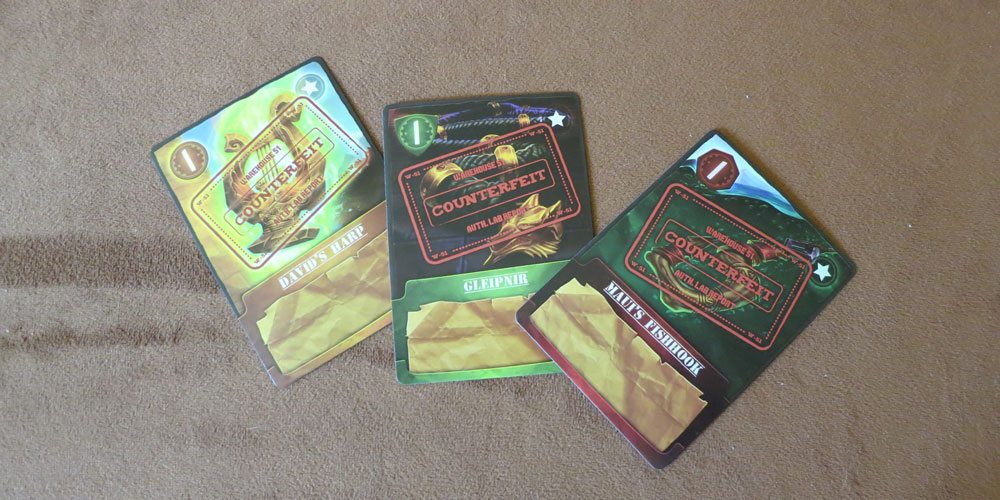
Some items have an icon of a closed fist on them. This indicates that these Relics must be bid on in a closed auction where players secretly put a number of ingots in their closed hands and everyone reveals their ingots at once. High bid wins and any ties must be challenged by the tying players with total bid amounts higher than each previous bid.
Should a player find her coffers have dwindled, she can pawn an item to the pawnbroker. This can even be done in the middle of an auction. Simply place a pawnbroker token on the pawned card and receive 5 ingots from the bank. At the end of the game, this Relic can be bought back from the pawnbroker, for 10 ingots, and, while it is in hock, any blessing the Relic provides is lost (although curses still apply). Relics can only be pawned if a player has 5 ingots or fewer.
Play continues until all of the Relics are purchased, and then chaos really sets in. Prior to scoring, players can buy back the aforementioned pawned Relics. If a player has one of two cards that grant Certificates of Authenticity, she can play that token on a Relic that she believes might be Counterfeit, making it legitimate. The Counterfeit cards that have been placed on the table are revealed and compared to cards in each player’s collection. Any Counterfeits that aren’t protected by Certificates of Authenticity are immediately discarded and any effect that Relic granted is lost. Other effects are resolved and scoring begins as described, above.
For example, here’s one scenario we ran into when playing: in a close race, a player (who may or may not be my son) thought he had enough blue cards to qualify for the highest value of Western fantasy and literature Relics, only to find that one of his highest valued Relics was nullified by a Counterfeit card he wasn’t privy to (which explained the snickering coming from the other side of the table when he bought it). Further pain was caused because he had the (blue, value 2) Malleus Maleficarum Relic, which states “If you do not end up scoring for 1st or 2nd place in this category, you lose 3 points.” Next thing he knew, he wasn’t in first. Instead, he was in third place and went from an 8 point gain to -3 points.

Verdict
At first blush, Warehouse 51 seems like a pretty simple game: bid and buy, most points wins. However, as you can see in the scenario just above, the sometimes horrible Relic effects and the frustration of incomplete information will leave you second-guessing whether or not you have enough Relics in a category to score or not. Rather than pursue dominance in a single category, you may end up better off going for second place in two groups.
The game is really accessible: it’s easy to pick up and play, even if you’ve never seen the rules before. While you may begin to anticipate cards after a few plays, first-time players aren’t at a significant disadvantage if they don’t know the effects beforehand.
When you’re in the thick of it, after the first 5 or 6 Relics have been purchased, gameplay becomes a bit of a conundrum. Conversations in your head might end up like this: Should you drive up the bid on Aladdin’s Lamp, even though you know it’s Counterfeit and you might get stuck with the Relic? You really want to win Pandora’s Box, but the bid is up to 8 ingots and that’s a lot of money to pass to your opponent on your left. On top of that, it will take a while for that money to make its way back around the table to you and you probably won’t be able to win anything until you get more cash without pawning something, but the Relic does allow you to choose another Counterfeit card that only you will know and … OK, move the bid to 9!
The auction mechanism is really interesting to watch, especially with new players. The idea of giving money to your opponent is initially met with a thriftiness that results in a bottleneck of ingots in front of many new players. However, they usually discover pretty quickly that you can’t win without Relics and the money begins flowing around the table. Greed trumps all.
The game’s premise and theme are pretty great and really add something special to playing. Like everything, it is pretty fun if you decide to incorporate a little role-playing into the game, affecting the aristocratic accent of Charles Cavendish (one of the characters on the player aids) when placing a bid.
While there is incomplete information, you can learn things by watching the others. When someone peeks at his Counterfeit card as a new red Relic is revealed and he doesn’t bid, maybe you shouldn’t either. Or is he just not bidding on Eastern Culture cards? It’s a lot of fun guessing, conniving, and bidding.
The only complaint I have about Warehouse 51 is that I wish there were a scoring track. Every time I’ve taught someone the game, when it came time for scoring, there are always a lot of “what do we do now” looks as we add up points. The game does recommend using ingots as victory points, but it doesn’t quite feel as appropriate as a score track. Maybe that’s just me.
It’s a small quibble, to be sure, but that’s indicative of how good the rest of it is. Sure, it’s a 30-minute game, which may qualify as filler for some of you, but it’s also a really good time. Everyone I’ve played with has walked away with a pretty big smile on their faces after playing, even if they were on the losing end. What more can you ask after visiting the top-secret vault holding America’s most valued treasures?
Warehouse 51 is scheduled to hit store shelves soon and will be retailing for just $25.
Disclosure: GeekDad was sent a copy of this game for review purposes.
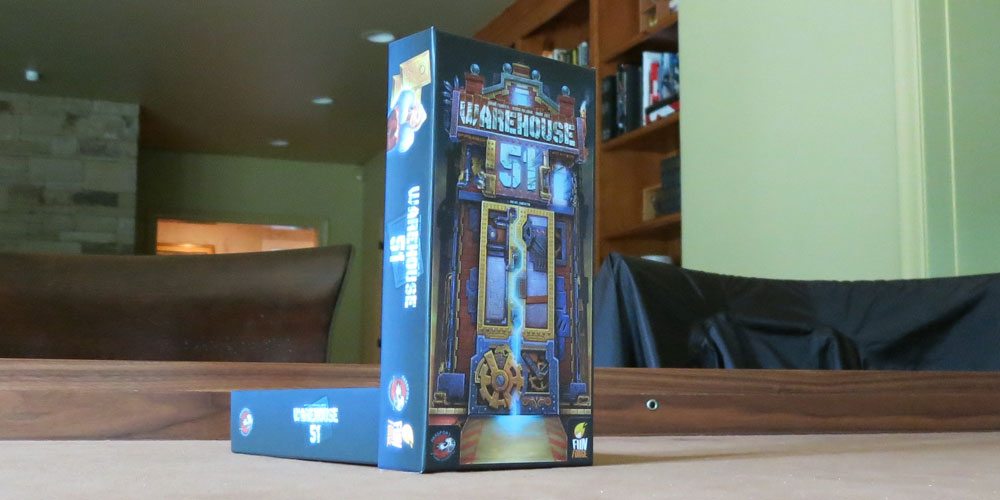
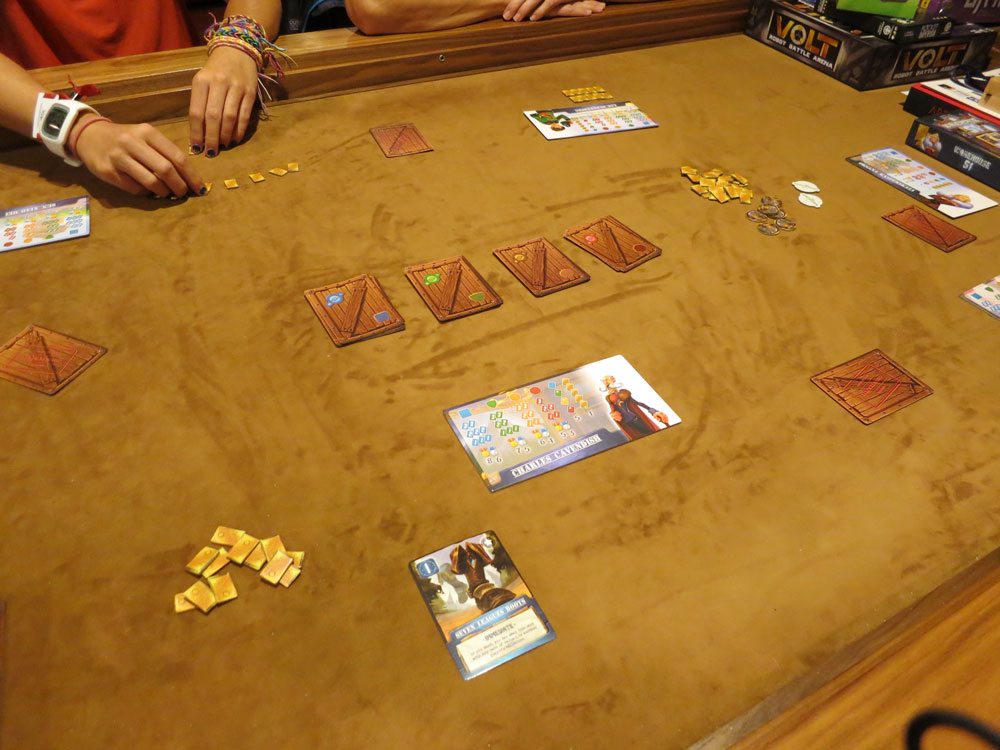
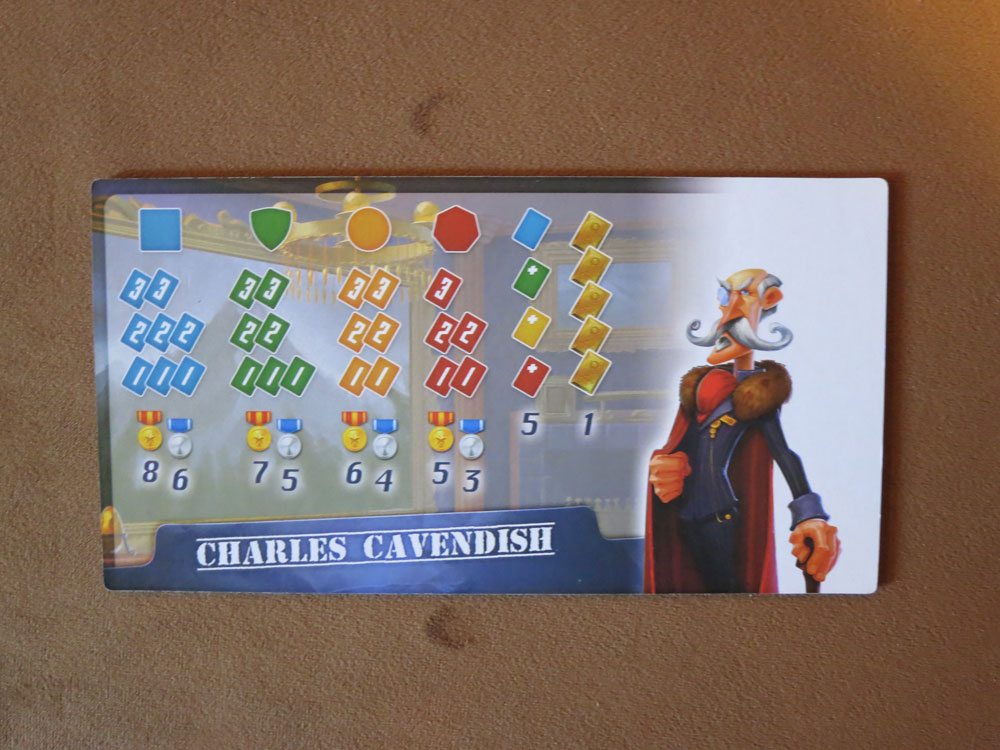
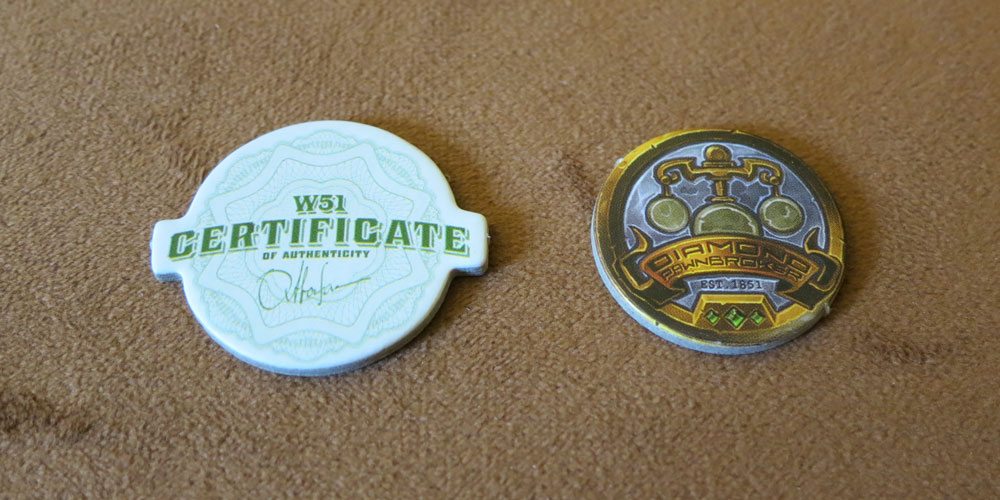


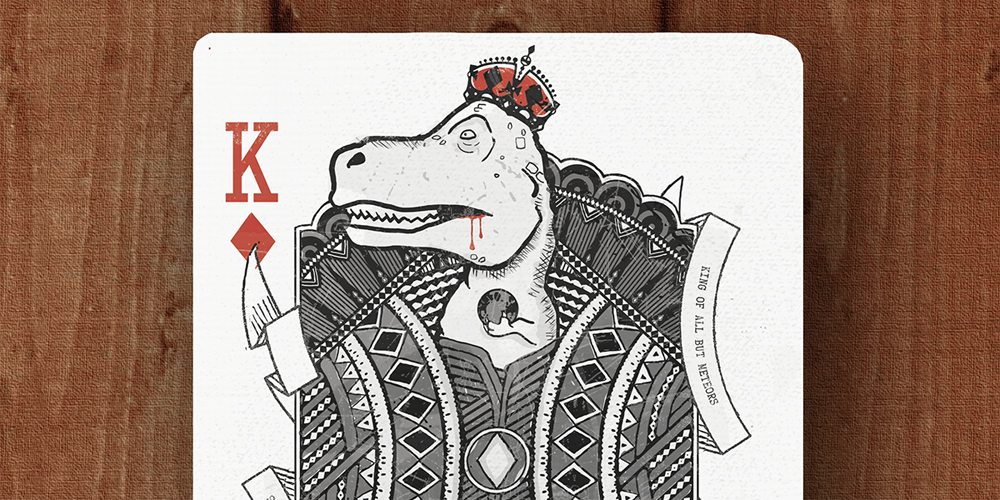


This seems great. Given how much fun we have with Citadels and SoN, it will probably make its way into the gaming cabinet. What I would kill for, though, is getting designers to balance games more toward an upper end of six players rather than five. While a lot of the things I play are fine capping out at five, we often play with two other sets of couples, or another couple plus our two children. It stinks when everyone wants to play the same thing, but someone has to sit out because there aren’t enough pieces, or play becomes broken at a certain level of players. Citadels, 7 Wonders, and Formula D only go so far (there are others, but you get the gist).
I played this one with Dave at Gen Con and it’s a good one. That whole “pay the player to your left” when you win an auction seems like a bizarre mechanic at first but it works and makes for some fascinating decisions.
I watched the DT review by Sam. He didn’t seem to get that the way bids are paid plus the hidden info plus each players’ set collecting goals are a source of tension/bluffing/fun. He barely mentioned the hidden info until half way through the video.
Sigh.